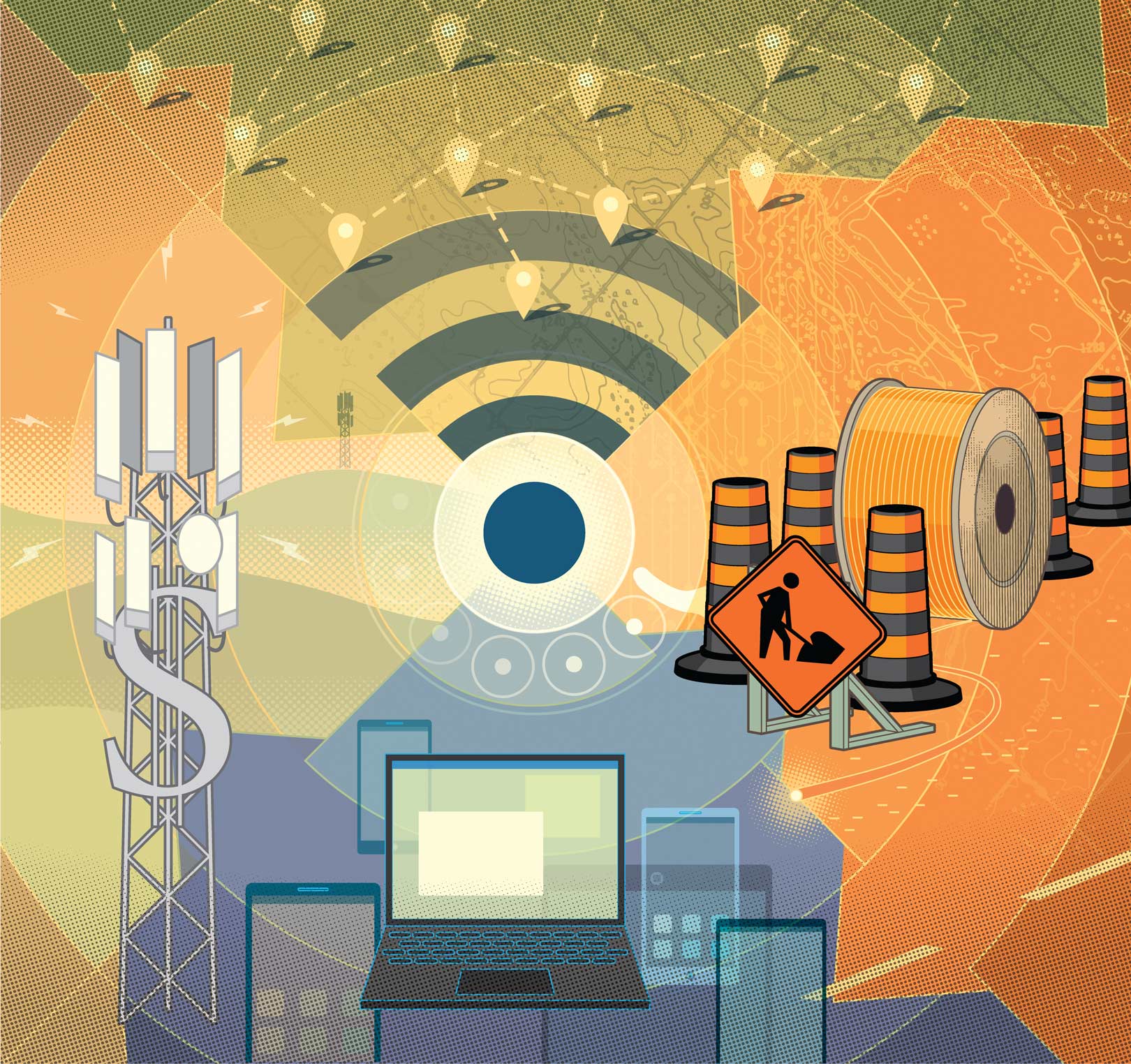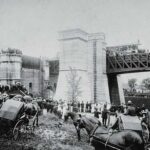
How our municipalities and rural communities are working toward a more connected future
Broadband internet access in rural Ontario is something that many of us can talk about from up-close-and-personal experience.
Rural communities continue to grapple with subpar or non-existent broadband infrastructure. As residents wait for a more connected future, essential services quickly shift to online delivery, and the pressing need for solutions that bridge the digital gap grows ever more urgent. The significant impacts of the internet on economic development, education, healthcare, and social inclusion have prompted every level of government to make sweeping commitments to improve it – but when will it happen, and what will it look like when it does?
On a county, and even a neighbourhood, level the patchwork of connectivity across the region is striking. While larger centres are adequately serviced, setting up shop – or home – just a few kilometres off the main drag in many cases means forgoing what should be an essential modern amenity. And that’s only considering those who have the luxury of choosing where they settle down. What choice do you have if your family farm has been in the area for generations?
Although we’re not there yet, there is evidence of real progress in high-speed internet on the way; some of it may even be just down the road from you, on large spindles ready to be rolled out. Lorelyn Morgan, artisan and owner of CoachHouse Clay Art in Northumberland says that a spool of fibre optic cable arrived at the end of her driveway over a year ago, but it has not yet been connected to her house. Close, however, only counts in horseshoes. Some people can’t wait. Meg Botha, Watershed’s art director, has had to switch to Elon Musk’s more expensive Starlink, a low-latency broadband satellite service, just to meet her current internet needs.
We looked into three areas in our region to learn
- Who is still underserved
- What the plans are for improvement
- What’s been accomplished so far
CONNECTING OUR COMMUNITIES?
The players on this stage are a range of public and private stakeholders, collaborating to patch up the connections and bring the region into the future. Investments trickle down from the federal and provincial governments to individual Internet Service Providers (ISPs) and municipalities.
On a local level, municipalities are tasked with coordinating and facilitating broadband projects in collaboration with ISPs. Rogers Communications, Bell Canada and TELUS – alongside smaller local companies such as Cogeco, KOS and Xplore or Tenacity – are responsible for the actual installation and maintenance of broadband infrastructure. A quick look at the Ontario Internet Access Map (connectednorth.ca) outlines in detail the patchwork service available within specific regions.
PRINCE EDWARD COUNTY
Total Households: 13,557
Unserved or Underserved Households: Over 7,000. A growing number of urban professionals, drawn by the charm of rural living and bolstered by the feasibility of remote work, are finding their place among the wineries and lakeside towns. These digital-native rural residents, nestled into renovated farmhouses, modern eco-homes and new housing developments, are not only broadening the demographic landscape of the area, but also infusing the local economy with fresh perspectives and entrepreneurial spirit.
In Prince Edward County over half of all residences have been identified as unserved or underserved by current broadband infrastructure. It’s been a topic of concern for many years, but change is on the way. With a $140 million investment ($49 million of that from Infrastructure Ontario), Rogers Communications began laying over 1,000 km of new buried and aerial fibre along the county’s roads at the end of 2022, which will eventually reach approximately 7,000 underserved properties.
The players on this stage are public and private stakeholders, collaborating to patch up the connections and bring the region into the future.
Mayor Steve Ferguson is optimistic: “We are pleased to see this project move forward. Expanded, upgraded and reliable connectivity will be a game-changer for the competitiveness of County-based businesses and services and open up new possibilities for people who currently or want to call Prince Edward County home.”
BELLEVILLE & QUINTE WEST
Total Households: 42,590
Unserved or Underserved Households: Over 2,200. In the rural areas that comprise the wards just north of Belleville and Quinte West, the average access rate is improved by connection to 4G cellular service that is mostly available across the region. In a lot of cases though, 4G is often all that’s reliably available to users, and currently only 62 percent of rural residents are guaranteed even that by the federal government.
As the sixth-generation on his family’s farm in Quinte West, Andrew Crews has had this conversation before. “Our government regulators and funders need to know that wireless internet service, in either the fixed-on-tower flavour or the mobile cellular flavour, isn’t a suitable substitute for investment in fibre infrastructure.”
Wireless data transmission systems, he continues, are engineered to allow maximum download speed, at the cost of upload speed – but it’s the upload speed that’s especially necessary to make use of new technologies that improve agricultural outcomes. “As agribusiness equipment becomes increasingly technological, machines are generating more and more data that is being uploaded to various cloud services for analysis. There will come a time in the near future when equipment is collecting high resolution images of every square metre of cropland for automatic plant health, weed detection, counting and identification, and pretty much anything you can think of.”
Fibre optics are the only solution for farmers of the future like Andrew Crews.
In Quinte West alone, there are over 2,200 residences and businesses identified as underserved by the current infrastructure, and the Crews farm is just one of them. Fibre optic is on its way to Quinte West, a project that sees the municipality working with multiple ISPs. Quinte West Director of Corporate Services, Brian Johnson, explains that the expansion project is spearheaded by Rogers Communications. Cogeco Connexion is also signed on to the project, and farms like Andrew’s can expect that either fibre-to-the-home via Bell or coaxial cable via Cogeco will be delivered before the end of 2024, relieving some of their reliance on cellular networks. Linda Lisle, Manager of Economic Development & Tourism Services, Quinte West says, “Access to high-speed internet is critical to supporting growth and development in the City of Quinte West. This important investment helps to reinforce the region as a competitive economy.”
Down the highway, Belleville – the most populous urban community in the region – boasts comparatively strong connectivity. But Belleville’s boundaries extend far beyond its densest core between the 401 and Highway 2, where fibre optic projects have been rolling out over the last two years.
Belleville’s beyond-the-border fibre optic project is well underway, and the most recent phase – geared toward boosting access in the municipality’s rural Thurlow Ward – is ticking toward a 2024 completion date. The expansion, which includes phases of coverage from both Rogers Communications and Bell Canada, could potentially provide internet speeds reaching up to 1.5 Gigabits per second. With two major players on the field, most users will find their needs met over the course of the next eighteen months.
NORTHUMBERLAND COUNTY
Total Households: 37,369
Unserved or Underserved Households: 13,448. Hills are the norm in Northumberland, and while they make for incredible views, they add a level of complexity to the delivery of broadband services. Of course, not everyone can simply build their home or start their business on top of a hill to access a cell tower, and running fibre through varied terrain has posed a challenge.
Northumberland County has identified broadband access as “a linchpin to local economic recovery” from the effects of the pandemic. Like other rural communities, complex regulatory requirements have resulted in infrastructure gaps that have left the county a patchwork of scattered connectivity.
There is much on the horizon, however. The Northumberland broadband project is planning to put shovels in the ground in the fall of 2023, with a target finish date of fall 2025.
Dan Borowec, Director of Economic Development and Tourism for Northumberland County says, “The economic impact of this project is widespread.” He compares the County/private partnership to installing “train tracks,” so internet service providers such as Bell or Cogeco (the companies that bring the news, movies and Google to your house) can run “their trains” that carry the content to you.
The project involves burying or stringing over 2,000 kilometres of fibre across 31 communities in Northumberland and providing a minimum speed of 1 GB – with capacity of up to 10 GB – to 13,448 unserved or underserved homes in Northumberland. The private sector will do the heavy lifting of installation, owning, operating and maintaining the fibre-to-the-home telecommunication service.
“Our farming community will be able to better access breaking edge high tech agricultural tools,” says Borowec. “Our current manufacturing community will be assured they have the connectivity required when introducing robotics and AI technology in their plants, our health care system will operate more efficiently and effectively, and by virtue of this type of connectivity we will attract workers who can work from home and individuals in the creative/information economy who traditionally nest in the connected urban regions. This is transformational change and is the bedrock of innovation.”
WHAT DOES THE FUTURE OF BROADBAND LOOK LIKE IN OUR REGION?
While it may be too soon to declare victory, the current trajectory shows promise. With a range of partners at various levels committed to bridging the digital divide, it’s reasonable to anticipate progress towards more equitable access to high-speed internet. The majority of projects in our communities are projected for completion by 2024 or 2025. This timeline aligns with the federal goal of connecting 100 percent of Ontario households by 2025. The developing networks are planned to deliver minimum internet speeds of 1 Gigabit per second (1 Gbps).
For longtime residents like multi-generational farmers, enhanced broadband access will revolutionize their day-to-day operations. They will be able to employ precision agriculture technologies, such as real-time data collection and analysis, remote monitoring of equipment and livestock, and drone-based crop management. These innovations will help increase productivity, reduce resource waste, and contribute to sustainable farming practices.
While the momentum from government initiatives, private sector investments, and community-driven solutions is encouraging, the road to ubiquitous broadband access remains challenging. What we know for sure is that we’ll get to witness yet another transformation in connectivity and what it means for our lifestyles – as individuals and as a community.
WHAT’S IN A GIG?
As we shift from 4G to 5G technology across the counties, faster and more efficient cellular data usage is on the way for some residents. Right now, more populated areas in the region can access 4G networks, with denser cities like Belleville and Port Hope seeing initial access to 5G. Promising speeds up to 100 times faster than its predecessor, 5G could dramatically reduce latency (the short delay before data transfer begins.) Most of us will first encounter this upgrade with near instant streaming of graphics and video, even when countless devices are connected to the network at once.
To put it simply, 4G is like a highway with a few lanes allowing cars to travel at decent speeds, while 5G is set to be a superhighway with numerous lanes and cars zooming along at astonishing speeds.
As with fibre optics, transitioning to 5G is a massive project involving the installation of new infrastructure. The 4G technology uses lower frequencies, ideal for larger areas with varied terrain and obstacles, thanks to their wide coverage and obstacle-penetrating abilities. It’s primarily delivered via spaced-apart large cell towers. 5G, however, uses a broader range including higher frequencies (up to 100 GHz compared to up to 6 GHz over 4G). Although these frequencies carry more data and offer faster speeds, they have a shorter range and struggle with obstacles like forests, hills and buildings. To counter this, 5G employs a mix of large cell towers for wide coverage and densely installed small cell towers for local coverage.
Story by:
Laura Voskamp
Illustration by:
Carl Wiens



